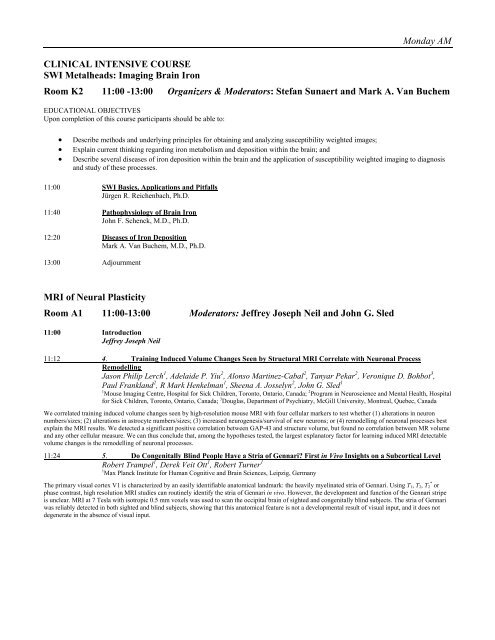OPENING SESSION - ismrm
OPENING SESSION - ismrm
OPENING SESSION - ismrm
You also want an ePaper? Increase the reach of your titles
YUMPU automatically turns print PDFs into web optimized ePapers that Google loves.
Monday AM<br />
CLINICAL INTENSIVE COURSE<br />
SWI Metalheads: Imaging Brain Iron<br />
Room K2 11:00 -13:00 Organizers & Moderators: Stefan Sunaert and Mark A. Van Buchem<br />
EDUCATIONAL OBJECTIVES<br />
Upon completion of this course participants should be able to:<br />
<br />
<br />
<br />
Describe methods and underlying principles for obtaining and analyzing susceptibility weighted images;<br />
Explain current thinking regarding iron metabolism and deposition within the brain; and<br />
Describe several diseases of iron deposition within the brain and the application of susceptibility weighted imaging to diagnosis<br />
and study of these processes.<br />
11:00 SWI Basics, Applications and Pitfalls<br />
Jürgen R. Reichenbach, Ph.D.<br />
11:40 Pathophysiology of Brain Iron<br />
John F. Schenck, M.D., Ph.D.<br />
12:20 Diseases of Iron Deposition<br />
Mark A. Van Buchem, M.D., Ph.D.<br />
13:00 Adjournment<br />
MRI of Neural Plasticity<br />
Room A1 11:00-13:00 Moderators: Jeffrey Joseph Neil and John G. Sled<br />
11:00 Introduction<br />
Jeffrey Joseph Neil<br />
11:12 4. Training Induced Volume Changes Seen by Structural MRI Correlate with Neuronal Process<br />
Remodelling<br />
Jason Philip Lerch 1 , Adelaide P. Yiu 2 , Alonso Martinez-Cabal 2 , Tanyar Pekar 2 , Veronique D. Bohbot 3 ,<br />
Paul Frankland 2 , R Mark Henkelman 1 , Sheena A. Josselyn 2 , John G. Sled 1<br />
1 Mouse Imaging Centre, Hospital for Sick Children, Toronto, Ontario, Canada; 2 Program in Neuroscience and Mental Health, Hospital<br />
for Sick Children, Toronto, Ontario, Canada; 3 Douglas, Department of Psychiatry, McGill University, Montreal, Quebec, Canada<br />
We correlated training induced volume changes seen by high-resolution mouse MRI with four cellular markers to test whether (1) alterations in neuron<br />
numbers/sizes; (2) alterations in astrocyte numbers/sizes; (3) increased neurogenesis/survival of new neurons; or (4) remodelling of neuronal processes best<br />
explain the MRI results. We detected a significant positive correlation between GAP-43 and structure volume, but found no correlation between MR volume<br />
and any other cellular measure. We can thus conclude that, among the hypotheses tested, the largest explanatory factor for learning induced MRI detectable<br />
volume changes is the remodelling of neuronal processes.<br />
11:24 5. Do Congenitally Blind People Have a Stria of Gennari? First in Vivo Insights on a Subcortical Level<br />
Robert Trampel 1 , Derek Veit Ott 1 , Robert Turner 1<br />
1 Max Planck Institute for Human Cognitive and Brain Sciences, Leipzig, Germany<br />
The primary visual cortex V1 is characterized by an easily identifiable anatomical landmark: the heavily myelinated stria of Gennari. Using T 1 , T 2 , T 2 * or<br />
phase contrast, high resolution MRI studies can routinely identify the stria of Gennari in vivo. However, the development and function of the Gennari stripe<br />
is unclear. MRI at 7 Tesla with isotropic 0.5 mm voxels was used to scan the occipital brain of sighted and congenitally blind subjects. The stria of Gennari<br />
was reliably detected in both sighted and blind subjects, showing that this anatomical feature is not a developmental result of visual input, and it does not<br />
degenerate in the absence of visual input.















